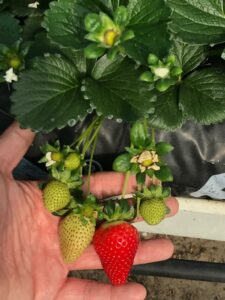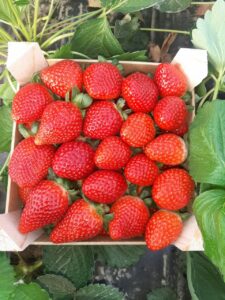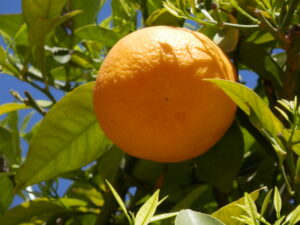Do Consumer Preferences Have an Impact on Agricultural Pollution and Food Waste?
What if consumers are responsible for part of agricultural pollution and food waste? Industrial farmers use chemicals to produce perfect-looking fruits and vegetables to meet consumer demands. Supermarkets reject imperfect-looking fruits and vegetables.
We interviewed Nabil Belmkaddem, an agricultural engineer and exporter of high-quality strawberries in Morocco, to better understand the relationship between consumer perfectionism and farmers’ use of chemicals.
European consumers want perfect-looking fruits and vegetables all year round
 Let’s explore the example of strawberries, a fruit that cannot be produced during winter in European latitude. Instead, the climate in Morocco – an absence of frost – allows the cultivation of strawberries during winter season. Strawberries cultivated there will be exported between November and March in Europe.
Let’s explore the example of strawberries, a fruit that cannot be produced during winter in European latitude. Instead, the climate in Morocco – an absence of frost – allows the cultivation of strawberries during winter season. Strawberries cultivated there will be exported between November and March in Europe.
Once on the European market, these strawberries must have a perfect appearance to be sold by supermarkets. Indeed, consumers refuse to buy fruits or vegetables with even a trace of insect bite or the beginning of rot. However, these imperfections do not make the fruit worse to eat. Actually, consumers could just cut off the part starting to rot and eat the rest of the fruit.
“End consumers refuse imperfect fruits and vegetables. They don’t buy them. For example, if a strawberry starts to rot the day after purchase, the consumer could return all the strawberry pack to the supermarket, who, in turn, apologizes”, explains Nabil Belmkaddem.
Zero tolerance for fruits and vegetables’ imperfections drives farmers and sorting centers to use chemicals
“Supermarkets have precise quality specifications. They can have a tolerance on coloring, for example, but concerning rot or insect bites, they have a zero-tolerance policy”, explains Nabil Belmkaddem.
 To sell the merchandise without incurring significant losses due to rejections, the farmer complies with the requirements of supermarkets. The farmer will use a certain number of chemical products:
To sell the merchandise without incurring significant losses due to rejections, the farmer complies with the requirements of supermarkets. The farmer will use a certain number of chemical products:
- particularly pesticides, to avoid insect bites on fruits and vegetables,
- and chemical fertilizers, to make them grow faster.
In the case of the strawberry, to ensure that it is perfectly shaped and early, the farmer will opt for patented varieties whose cultivation requires using pesticides for phytosanitary protection. Once harvested, only the perfect-looking strawberries can be sent to packhouses and then delivered to supermarkets in Europe, which will throw away all those considered imperfect.
In the case of some other fruits and vegetables – such as apples, oranges, or tomatoes-, once harvested, they are sent to a sorting center where additional chemicals are added: coloring agents for color a few days before the fruit is sold, artificial sweeteners for sweetness, preservatives to delay rotting, and kerosene to give the fruit its shiny appearance.(1)
The impacts of producing perfect-looking fruits and vegetables

Chemical products added by the farmer during the production phase, and the sorting centers during the distribution phase, negatively impact the environment and the quality of the product purchased by the consumer.
Pesticides and herbicides used to cultivate fruits and vegetables pollute the water table, kill biodiversity, and ultimately impoverish or destroy the soil. After using these products, the soil becomes poor as it contains very few nutrients. As a result, the fruit or vegetable will also lack nutrients.
Secondly, adding chemicals by the sorting center at the distribution phase penalizes the final consumer who buys a fruit or vegetable that looks perfect but is not fresh.
“It is important to note, however, that red fruits – strawberries and raspberries – are sent to packhouses that add no chemical to the fruits”, explained Nabil Belmkaddem.
Finally, we must consider the impact of wasted imperfect fruits and vegetables because supermarkets and consumers refuse them.
“The supermarket, as well as the consumer, throw away a strawberry because of a tiny trace; it is a shame,” exclaims Nabil Belmkaddem.
What about educating consumers differently?
What if the media taught adults that an imperfect fruit or vegetable does not mean that it is terrible? Shouldn’t schools explain this to children at an early age?
“Consumers have always been taught to choose perfect fruits and vegetables that shine. However, to shine, you need to add wax. We must educate consumers to understand that a trace of insect bite or the beginning of rot is normal and that cutting these imperfect parts with a knife solves the issue”, adds Nabil Belmkaddem.
Instead of demanding a perfect appearance, why not request a good product from a health and nutrition point of view? If consumers change their behavior, it will have a massive impact on food waste reduction, soils and water table chemical pollution.
Would you buy imperfect fruits or vegetables?
 Nabil Belmkaddem is an agricultural engineer with a Master’s Degree from California State University. He has 17 years of solid agricultural experience in Morocco and specializes in strawberry production.
Nabil Belmkaddem is an agricultural engineer with a Master’s Degree from California State University. He has 17 years of solid agricultural experience in Morocco and specializes in strawberry production.




